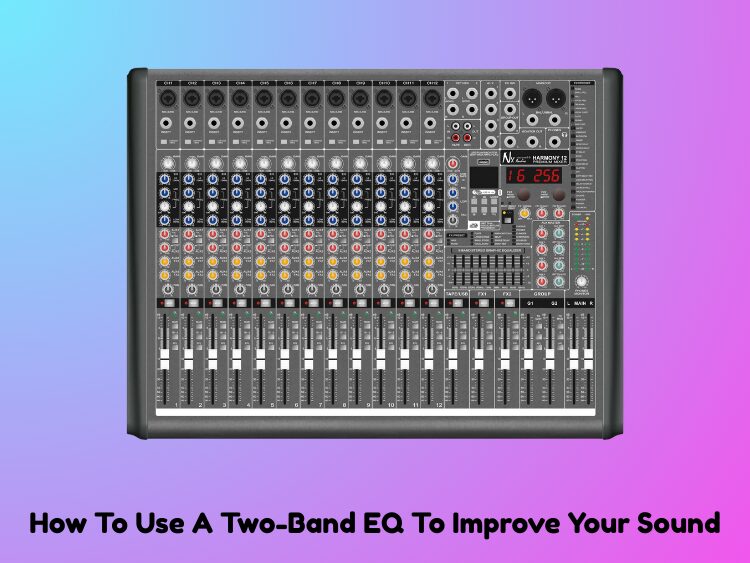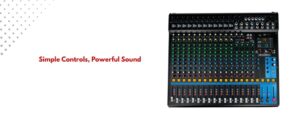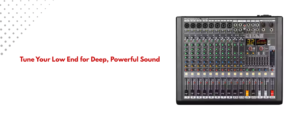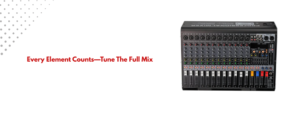EQ (equalization) is one of the most powerful tools for changing how your sound sounds. You can make your mix much better with even the most basic two-band EQ, which lets you control bass (low frequencies) and treble (high frequencies), whether you’re working live or in the studio. Even though more modern systems have multi-band EQs, learning how to use a two-band EQ correctly can help you get great sound. Here are some good ways to use a two-band EQ to improve sound quality without making your work too hard.
What is a Two-Band EQ?
You can change two main ranges of sound with a two-band EQ:
- Low frequencies (Bass): Usually ranges from 20 Hz to 250 Hz. The kick drum, bass guitar, and lower voice tones are all in this range.
- High Frequencies (Treble): Can be anywhere from 4 kHz to 20 kHz. This is where sibilance in the voice, hi-hats, and drums live.
Since a two-band EQ doesn’t let you change the mid-frequency, it’s great for quick fixes, live sound, and mixing jobs for beginners. If you’re looking to dive deeper into mixing and understand how audio mixers handle sound frequency ranges, this guide can help.
Step 1: Set the EQ to “Neutral”
To start, set the EQ knobs to 12 o’clock, which means “flat.” This is your standard of balance. Before you boost or cut anything, make sure you listen to the initial sound very carefully. Before you turn any knobs, you should always trust your ears. If you’re new to mixing, it’s worth checking out mixing tips for live streaming to optimize your settings further.
Step 2: Adjust the Low Frequencies (Bass)
To Boost Bass:
If your mix sounds thin or weak, add a little more low frequency to it. This can make kick drums, bass guitars, and male voices sound fuller. For instance, a small bass boost can make a singer-songwriter’s show sound warmer if only singing and an acoustic guitar are used.
To Cut Bass:
Tone down the low frequencies if the sound is fuzzy or boomy, especially in small rooms or with bad speakers. People often need this at outdoor events or club gigs with many people, where low-end building is common.
It’s best to avoid heavy low-end boosts because they can make the mix sound too loud or cause speaker distortion. Making changes in small increments will help. If you’re exploring bass and its impact on sound, check out trending audio mixer technology for 2025 for insights on how modern mixers deal with bass frequencies.
Step 3: Adjust the High Frequencies (Treble)
To Boost Treble:
If the mix sounds boring or unclear, especially when voices or acoustic instruments are present, slightly raise the high frequencies. This improves small things, like how vocals are articulated, drum hits, or cymbal shine.
To Cut Treble:
Reduce the low frequencies if the sound is overly loud, sharp, or hissy. This often happens when mics aren’t very good or when areas aren’t properly handled, and high-end echoes happen.
Tip: Avoid boosting treble in already bright mixes—it can lead to harsh or shrill tones. Instead, cut high frequencies to soften the sound.
Step 4: Listen to the Whole Mix
Listen to the whole mix again after each change. A setting that makes one thing better might make something else worse. If you use EQ, you should always think about the whole sound, not just one instrument or voice.
As you mix a live event, make sure you look around the room. What sounds even at the mixer might not sound the same in different parts of the room.
Step 5: Use EQ to Improve Gear Performance
When working with small PA systems, cheap mixers, or movable sets, a two-band EQ is very helpful. If the EQ on your speaker or amplifier is only basic, use it to fix the way the room sounds, stop echoes, or make the sound clearer.
As an example:
- Cut down on the lows if your voice mic sounds boxy.
- If your acoustic guitar doesn’t have enough sparkle, raise the highs a bit.
Last Thoughts
You can improve the sound quality if you use your tools carefully and with a good ear. It may seem like a two-band EQ doesn’t give you much power, but it can make big changes if you know how to use it right. If you know how to handle low and high levels correctly, you can make a rough mix sound clean and professional, whether playing live, making a show, or practicing in your shed. Make things easy, pay attention, and let your EQ help you, not hurt you.




